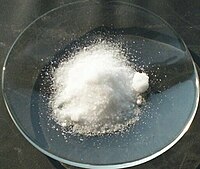
Photo from wikipedia
A modified outdoor large-scale nutrient recycling system was developed to compost organic sludge and aimed to recover clean nitrogen for the cultivation of high-value-added microalgae. This study investigated the effect… Click to show full abstract
A modified outdoor large-scale nutrient recycling system was developed to compost organic sludge and aimed to recover clean nitrogen for the cultivation of high-value-added microalgae. This study investigated the effect of calcium hydroxide addition on enhancing NH3 recovery in a pilot-scale reactor self-heated by metabolic heat of microorganisms during thermophilic composting of dewatered cow dung. 350 kg-ww of compost was prepared at the ratio of 5: 14: 1 (dewatered cowdung: rice husk: compost-seed) in a 4 m3 cylindrical rotary drum composting reactor for 14 days of aerated composting. High compost temperature up to 67 °C was observed from day 1 of composting, proving that thermophilic composting was achieved through the self-heating process. The temperature of compost increases as microbial activity increases and temperature decreases as organic matter decreases. The high CO2 evolution rate on day 0-2 (0.02-0.08 mol/min) indicated that microorganisms are most active in degrading organic matter. The increasing conversion of carbon demonstrated that organic carbon was degraded by microbial activity and emitted as CO2. The nitrogen mass balance revealed that adding calcium hydroxide to the compost and increasing the aeration rate on day 3 volatilized 9.83 % of the remaining ammonium ions in the compost, thereby improving the ammonia recovery. Moreover, Geobacillus was found to be the most dominant bacteria under elevated temperature that functions in the hydrolysis of non-dissolved nitrogen for better NH3 recovery. The presented results show that by thermophilic composting 1 ton-ds of dewatered cowdung for NH3 recovery, up to 11.54 kg-ds of microalgae can be produced.
Journal Title: Waste management
Year Published: 2023
Link to full text (if available)
Share on Social Media: Sign Up to like & get
recommendations!